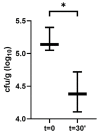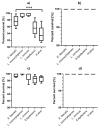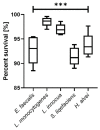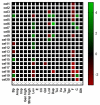Ceviche-Natural Preservative: Possibility of Microbiota Survival and Effect on L. monocytogenes
- PMID: 35327282
- PMCID: PMC8950590
- DOI: 10.3390/foods11060860
Ceviche-Natural Preservative: Possibility of Microbiota Survival and Effect on L. monocytogenes
Abstract
Ceviche is a marinated raw fish dish ready for consumption; it is a part of the cuisine of various countries on the Pacific coast and its preparation may differ among them. Although the process uses the traditional method of food preservation by lowering the pH, the exposure time is very limited, so the aim of the study was to determine the viability of bacteria often isolated from fish after the process of preparing traditional ceviche. For this purpose, the traditional plate method and flow cytometry were used, and for pathogenic L. monocytogenes strains, the influence of stress during the preparation of the dish on the pathogenic potential was determined. The study showed that the highest percentage of viable cells was observed in the case of L. monocytogenes and remained at the level of 98.54%, slightly less for L. innocua, 96.93%. For the remaining species the reduction did not exceed 10%, for E. faecalis it was 92.76%, for S. liqefaciens 91.44%, H. alvei 93.68%. In addition, the study of the antibacterial properties of individual ingredients showed that habanero and coriander did not show any bactericidal effect, while for onions the amount of live cells was 99.11%, and for lime juice 97.26%, Additionally, the study of changes in virulence, antibiotic resistance and gene expression showed that the stress during the preparation of ceviche has different effects depending on the strain and may cause virulence potential increase, levofloxacin and daptomycin minimum inhibiotory concentration increase and some crucial virulence gene expression induction; therefore, it is important to take care of the quality of the products used to prepare the ceviche and accurate pretreatment.
Keywords: Listeria; Listeria monocytogenes; ceviche; survival.
Conflict of interest statement
The authors declare no conflict of interest.
Figures






Similar articles
-
Effect of lime juice on Vibrio parahaemolyticus and Salmonella enterica inactivation during the preparation of the raw fish dish ceviche.J Food Prot. 2013 Jun;76(6):1027-30. doi: 10.4315/0362-028X.JFP-12-526. J Food Prot. 2013. PMID: 23726199
-
Extinction of Vibrio cholerae in acidic substrata: contaminated fish marinated with lime juice (ceviche).Rev Biol Trop. 1994 Dec;42(3):479-85. Rev Biol Trop. 1994. PMID: 7501869
-
Incidence of Vibrio cholerae in Fresh Fish and Ceviche in Guadalajara, Mexico.J Food Prot. 1997 Mar;60(3):237-241. doi: 10.4315/0362-028X-60.3.237. J Food Prot. 1997. PMID: 31195485
-
Survival of Vibrio cholerae O1 in ceviche and its reduction by heat pretreatment of raw ingredients.J Food Prot. 2000 Apr;63(4):445-50. doi: 10.4315/0362-028x-63.4.445. J Food Prot. 2000. PMID: 10772208
-
Inactivation by lemon juice of Escherichia coli O157:H7, Salmonella Enteritidis, and Listeria monocytogenes in beef marinating for the ethnic food kelaguen.Int J Food Microbiol. 2013 Jan 1;160(3):353-9. doi: 10.1016/j.ijfoodmicro.2012.11.009. Epub 2012 Nov 20. Int J Food Microbiol. 2013. PMID: 23290245
Cited by
-
Green label marinades: A solution to salmonella and campylobacter in chicken products?Heliyon. 2023 Jul 4;9(7):e17655. doi: 10.1016/j.heliyon.2023.e17655. eCollection 2023 Jul. Heliyon. 2023. PMID: 37483745 Free PMC article.
-
An Exploratory Study on Spoilage Bacteria and Listeria monocytogenes in Fresh Salmon: Extending Shelf-Life Using Vacuum and Seasonings as Natural Preservatives.Vet Sci. 2023 Jun 29;10(7):423. doi: 10.3390/vetsci10070423. Vet Sci. 2023. PMID: 37505828 Free PMC article.
-
Impact of the Food-Related Stress Conditions on the Expression of Enterotoxin Genes among Staphylococcus aureus.Pathogens. 2023 Jul 19;12(7):954. doi: 10.3390/pathogens12070954. Pathogens. 2023. PMID: 37513801 Free PMC article.
References
-
- Ramírez-Martínez M.E., Rodríguez-Castillejos G.C., Hernández-Jiménez M.C., Ramírez-Quintanilla L.Y., Siller-López F., Acosta-Cruz E., Martínez-Montoya H. Analysis of microbial diversity in raw fish ceviche. bioRxiv. 2020 doi: 10.1101/2020.06.24.170217. - DOI
-
- Farber J.M., Zwietering M., Wiedmann M., Hedberg C.W., Harrison M.A., Hartnett E., Chapman B., Donnelly C.W., Goodburn K.E., Gummalla S. NC-ND license Alternative approaches to the risk management of Listeria monocytogenes in low risk foods. Food Control. 2021;123:107601. doi: 10.1016/j.foodcont.2020.107601. - DOI
Grants and funding
LinkOut - more resources
Full Text Sources
Research Materials

